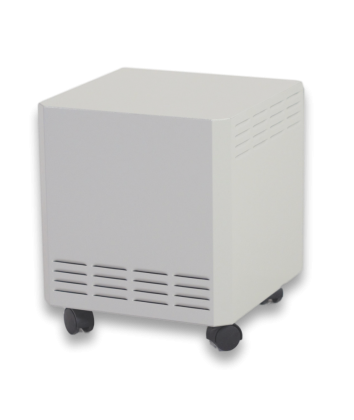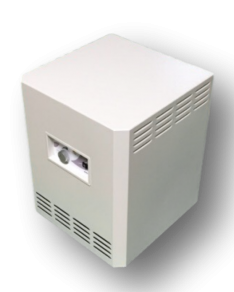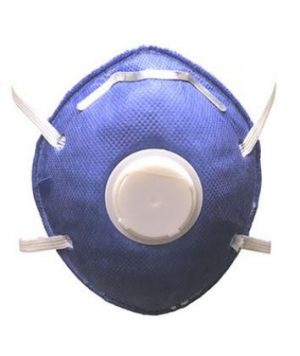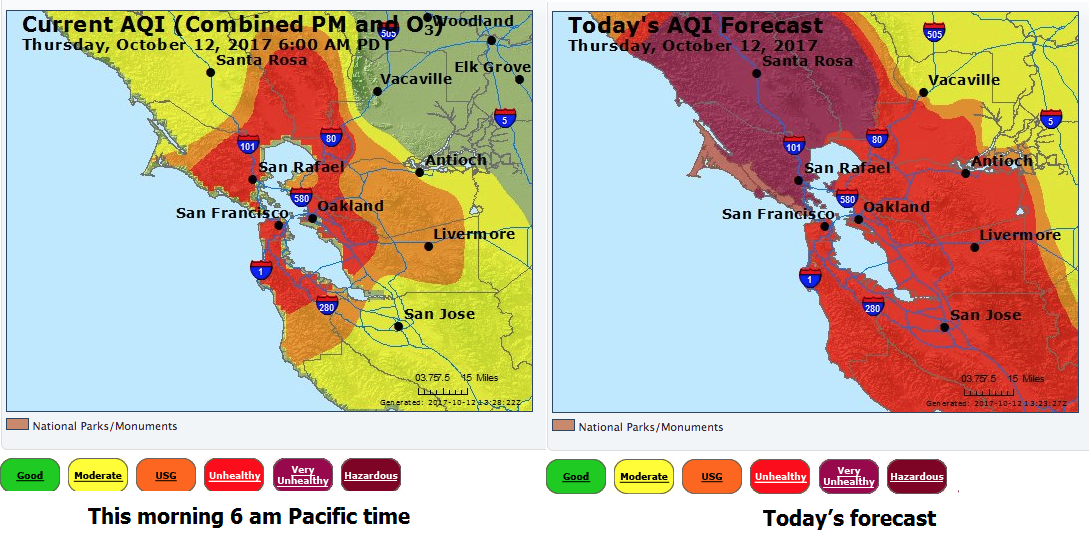On Sunday evening I went out to dinner with my family to a local restaurant. It was a pleasant evening and we sat on benches out in front of the restaurant quite comfortably while we waited for our table. When we walked out the door of the restaurant after dinner, there were gusts of wind so strong that I said, “A storm is coming!”
And then I remembered I was in California. In Florida, where I had been living for 15 years, this wind would mean I should go inside somewhere because very soon there would be a downpour with thunder and lightning. But this was California. There were few thunderstorms. But on Sunday night I was right. The winds created a firestorm.
Because of the winds, the fire spread quickly over a large area, with flying embers instantly igniting a dry landscape. Last I heard there are now 21 fires burning. There haven’t been enough firefighters. But firefighters and military from all over the country are being sent. Yesterday the firefighters numbered 8000. And still no containment.
While the winds carried the fires in the direction opposite from where I am living, the smoke from these fires has been terrible. I am only about 15 miles from the largest fires.
Outdoor Air Quality Warnings
Depending on where you live, you might not ever think about the quality of air outdoors. On my website, I focus on the quality of air inside homes and sources of unhealthy pollutants, but indoor air quality actually begins with outdoor air quality. I learned this many years ago when I and a friend created a nontoxic home for him in an area near downtown Oakland, California that had highly polluted outdoor air. Even though everything inside was perfectly nontoxic, he couldn’t live in the house because of the quality of the outdoor air. So I always start with the outdoor air quality when I am choosing a place to live.
But outdoor air quality is an issue in many places, so much so that our government has created the Air Quality Index to inform the public when outdoor air pollution reaches a level that can be harmful to health.
Local air quality affects how you live, how you breathe, and your health. Just like the weather, it can change from day to day and even hour to hour. So the US Environmental Protection Agency (EPA) and your local air quality management agency has made information on air quality as easy to understand as a weather report. And you’ll often see or hear this information as part of a weather report.
Air Quality Index
The Press Democrat newspaper reported “a monitor in Napa recorded an air quality index of 442 Monday morning, with a high of 292 in San Rafael.” By later in the day these areas measures 159 for Napa and 164 for San Rafael, showing the smoke moving away from the source fire and into the surrounding area.
On Monday at our house, which is about 15 miles from the fire, the sky was thick with smoke all day. Charred leaves were falling from the sky and ash was blowing continuously like snow. We stayed indoors as instructed but still the air smelled like smoke.
Larry and I went to sleep early but woke up around midnight. Larry was wheezing so badly that every exhale sounded like kittens mewing. I felt like I soon was not going to be able to breathe. With my interest in indoor air quality I always felt like even if the indoor air pollution was bad, I could always go outside and breathe. But now there was no clean air outside to breathe.
We got out of bed and drove for a half hour to Bodega, which is right on the Pacific Ocean. We opened all the windows of the car and breathed deeply the clean air. Fortunately, we were able to find a room at a lodge and could sleep through the night. But by morning the smoke had reached the ocean too.
This was now Tueday morning. We checked the television and found that the entire San Francisco Bay Area had the UNHEALTHY air index. We would have to drive for hours to get into clean air.
But our area is not the only place in California with smoke from wildfires. Cal Fire tracks all the fires in the state of California. Here’s the current map:

The Chemical Composition of Smoke
The exact composition of any sample of smoke depends on the material that is being burned. But in general, smoke—whether it comes from a cigarette or a house fire—is made up of particles and gasses. The type and amount of particles and gasses in smoke varies depending on what is burning, how much oxygen is available, and the burn temperature.
Particles are irritating, but gasses can be toxic.
I mention this because I am seeing people walking around wearing particle masks, which protect their lungs from particles, but not gasses.
CHEMICAL COMPOSITION OF WOOD SMOKE
| carbon monoxide | methane |
| VOCs* (C2-C7) | aldehydes |
| substituted furans | benzene |
| alkyl benzenes | acetic acid |
| formic acid | nitrogen oxides |
| sulfur dioxide | methyl chloride |
| napthalene | substituted napthalenes |
| oxygenated monoaromatics | total particle mass |
| particulate organic carbon | oxygenated PAHs |
| Individual PAHs | chlorinated dioxins |
| normal alkanes (C24-C30) | sodium |
| magnesium | aluminum |
| silicon | sulfur |
| chlorine | potassium |
| calcium | titanium |
| vanadium | chromium |
| manganese | iron |
| nickel | copper |
| zinc | bromine |
| lead |
The Health Effects of Breathing Smoke
According to the New York State Department of Health
Exposure to high levels of smoke should be avoided. Individuals are advised to limit their physical exertion if exposure to high levels of smoke cannot be avoided. Individuals with cardiovascular or respiratory conditions (e.g., asthma), fetuses, infants, young children, and the elderly may be more vulnerable to the health effects of smoke exposure.
Inhaling smoke for a short time can cause immediate (acute) effects. Smoke is irritating to the eyes, nose, and throat, and its odor may be nauseating. Studies have shown that some people exposed to heavy smoke have temporary changes in lung function, which makes breathing more difficult. Two of the major agents in smoke that can cause health effects are carbon monoxide gas and very small particles (fine particles, or PM2.5 ). These particles are two and one half (2.5) microns or less in size (25,400 microns equal an inch) and individual particles are too small to be seen with the naked eye.
Inhaling carbon monoxide decreases the body’s oxygen supply. This can cause headaches, reduce alertness, and aggravate a heart condition known as angina. Fine particles are able to travel deeply into the respiratory tract, reaching the lungs. Inhaling fine particles can cause a variety of health effects, including respiratory irritation and shortness of breath, and can worsen medical conditions such as asthma and heart disease. During increased physical exertion, cardiovascular effects can be worsened by exposure to carbon monoxide and particulate matter. Once exposure stops, symptoms from inhaling carbon monoxide or fine particles generally diminish, but may last for a couple of days.
Read also AIR NOW: How Smoke from Fires Can Affect Your Health
How to Protect Yourself From Smoke if You Live Near a Fire
On the first day of the fires, TV news shows told us tp stay indoors to avoid the smoke outdoors. But this doesn’t seem like enough to me.
Here are more things you can do:
1. If you can, drive somewhere else outside of the smoky area.
2. Get a face mask that filters both particles and gasses. Read this about choosing the proper face mask and how to use it correctly.
3. Run your HVAC system to filter air from outside. Recirculating air in your home for too long can reduce oxygen levels. Keep a supply of HVAC filters on hand so you can change them as needed. Check the filter daily to see if it needs to be changed while the outdoor air is smoky.
4. Use an air filter that filters out both particles and gasses.
How to Relieve Symptoms Caused by Smoke Inhalation
First, just drink a lot of water. I have a bottle of water with me and I’m sipping it all day. Smoke will really dry your body out, and your body needs even more liquid at this time.
A major problem from smoke inhalation is all the particles in the air clog the cilia, little “oars” in the respiratory tract, sinuses and lungs that move foreign materials through the system.
To clear the cilia, drink hot liquids. Hot liquids stimulate the cilia to move and this in turn can help get the mucus moving so you can swallow it or cough it up. This removes the mucus containing the contaminants from your respiratory system, where it can do further damage.
If you really are having trouble breathing, go to your nearest emergency medical facility. There they can give you oxygen, which is the standard treatment for smoke inhalation.
Larry and I did drive away from the smokey area when it became clear we were starting to have breathing difficulties. But then when the smoke came to where we were, we drove back to Sebastopol and got my air filter out of the storage locker and brought it home and set it up. And we both were able to breathe comfortably indoors and haven’t had any problems since.
PRODUCTS THAT CAN HELP REDUCE SMOKE INHALATION
 |
 |
 |
| EnviroKlenz Mobile Air System |
EnviroKlenz Mobile Unit UV Model |
EnviroKlenz Breathing Mask |
| HEPA filter for particles plus patenting hospital-grade technology that removes and neutralizes VOCs, bad odors, and fragrances. | EnviroKlenz Mobile Air System plus a UV light to inhibit the growth of captured bacteria, molds, and viruses | Removes both particles and toxic gasses that are present in smoke |
| More.. | More.. | More.. |







Thanks for posting this. I haven’t done any more research on it, so appreciate that you have.
Hi, Debra, I am so sorry about all the problems these terrible fires are causing you and so many other people! When I see the firefighters battling a fire, I am always wondering about the chemicals that they spray. I just saw a video of planes spraying red colored chemicals on the fires in California also, and I am worried about the incredible amount of toxic stuff that they have to use on such large areas. Do you know what they use and what effect it will have on people and the environment?
Wishing you the best and hope that you and Larry stay safe! Judith
The material is called Phos-Chek.It is primarily made up of 85% water, 10%fertilizer (ammonia phosphate and sulfate ions), and 5% minor ingredients(iron oxide for color, clay or bentonite). It works by coating the ground, buildings and plants with a moisture (like water, but has a stickiness to it). It is usually dropped by aircraft and reduces the flammability of the fuel on the ground. It is non-toxic to humans if it gets on your skin but can be harmful to animals if swallowed. It is red because once dropped it is easily visible from the air and on the ground.
Here’s a video about it, made by the manufacturer: https://www.youtube.com/watch?v=EcP_1j12eIY
Hi Debra. I was told the same thing as you about what’s in Phos-Chek. But my husband found a 2017 article saying that some residents of Northern California have had bad reactions to it, and that it contains toxic chemicals, ammonia, and nitrate. We are in the midst of fire season and planes are dropping this stuff all over the place up here in Oregon so now I have one more thing to worry about (I’m thinking about moving to another planet).
Have you done any more research on Phos-Chek? In this article it’s called LC95A: https://www.newstarget.com/2018-07-17-california-residents-break-out-in-bizarre-rashes-after-forest-fires-burn.html
And here’s an interesting piece about a lawsuit against the U.S. Forest Service by a group called Forest Service Employees for Environmental Ethics: https://www.hcn.org/issues/43.10/fire-fight-forest-service-finally-reveals-the-hazards-of-chemical-retardants. (the study was referenced in the other article, but my computer said the site hosting it was unsafe and refused to access it)
Would love to hear your thoughts.
Of course I think they shouldn’t be dropping this all over California and Oregon and other places. But I’m not sure how to get them to stop.
I haven’t done any more research on this, so I appreciate that you have.
Keep spreading the word wherever you can, especially during fire season.